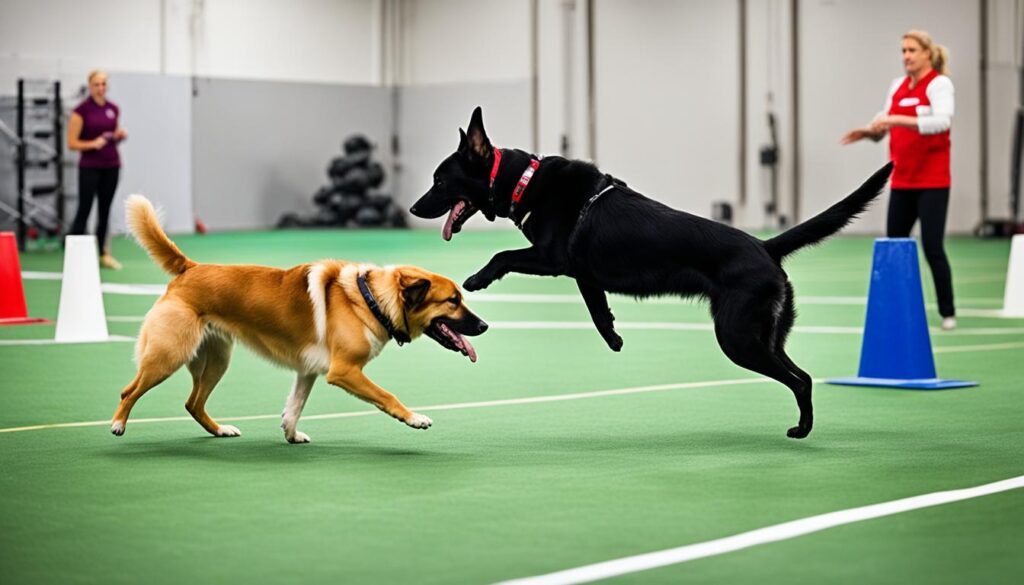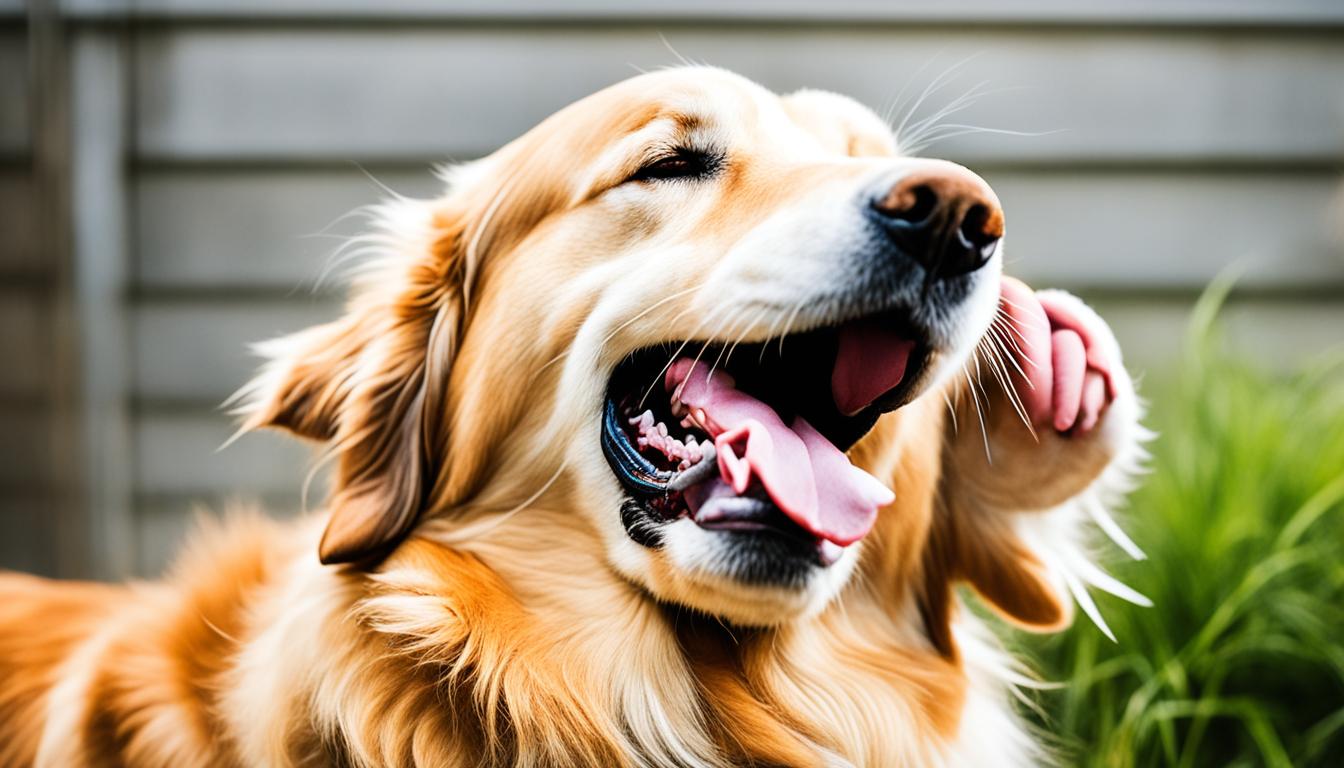Yes, it’s true! Dogs have the capacity to comprehend around 165 words on average. These clever animals can grasp and act upon verbal instructions, so teaching them commands is crucial for their growth and development.
In this article, we will provide expert tips on mastering dog commands to help you effectively communicate with your furry friend. Whether you’re looking to teach your dog basic commands or advance their training, our tips and techniques will guide you every step of the way.
Key Takeaways:
- Training your dog with commands strengthens the bond between you and your furry companion.
- Consistency and positive reinforcement are key factors in successful dog training.
- Mastering essential commands like ‘sit’ and ‘stay’ provide the groundwork for teaching other behaviors.
- Useful commands like ‘drop it,’ ‘down,’ and ‘leave it’ promote safety and well-being in everyday situations.
- Safety commands such as ‘come’ and ‘off’ are crucial for outdoor activities and public spaces.
Understanding the Basics of Dog Training
Before we dive into the specifics of dog training, it’s crucial to grasp some fundamental principles. Consistency and positive reinforcement are vital components of a successful training program. By setting aside dedicated practice time, utilizing rewards and praise to reinforce positive behavior, and maintaining consistent and concise command phrases, you can establish a solid foundation for effective training.
Consistency is key when training your furry friend. Dogs thrive on routine, so it’s important to establish clear expectations and boundaries. Consistently using the same command words and gestures will help your dog understand what is expected of them and foster effective communication.
Positive reinforcement is a powerful tool in dog training. It involves rewarding desired behaviors to encourage their repetition. A treat, gentle pat, or enthusiastic verbal praise can make a world of difference in motivating your dog to respond correctly to your commands.
Remember, the goal is to create a positive and rewarding learning experience for your dog. Using punishment or harsh methods can be counterproductive and damage the trust between you and your furry companion.
Training commands should be kept consistent and concise to make them easier for your dog to understand and remember. Use short phrases or single words, delivered in a clear and confident tone, and avoid lengthy sentences that might confuse your furry friend.
By following these rules of thumb, you’ll establish a strong and effective training routine that will not only help your dog learn and respond to commands but also deepen the bond between you and your faithful companion.
Avoid These Common Training Mistakes
- Inconsistency: Changing your command words or using inconsistent body language can confuse your dog and impede their learning.
- Lack of Patience: Remember that every dog learns at their own pace. Be patient and give your furry friend time to understand and respond to your commands.
- Neglecting Rewards: Forgetting to reward your dog for their correct responses can demotivate them and make training less effective.
- Overuse of Negative Reinforcement: It’s important to strike a balance between positive reinforcement and corrective measures. Relying too heavily on punishment can have adverse effects on your dog’s willingness to learn.

By understanding the basics of dog training and implementing these rules of thumb, you’re setting yourself and your furry friend up for success. Consistency, positive reinforcement, and concise command phrases are the cornerstone of effective dog training. Stay tuned for the next section, where we’ll delve into mastering essential commands like “sit” and “stay.”
Mastering Essential Commands: Sit and Stay
In dog training, two commands stand out as the foundation for many other behaviors: the “sit” command and the “stay” command. Teaching your dog these essential commands is crucial for their safety, obedience, and overall well-being.
The Sit Command: The sit command is a fundamental cue that allows you to control your dog’s behavior effectively. It can be taught using the luring technique, which involves holding a treat in front of your dog’s nose and slowly moving it back over their head. As their head follows the treat, their bottom will naturally lower into a sitting position. Remember to use a verbal cue, such as saying “sit,” as you guide your dog with the treat. Consistency is key to reinforce this command and ensure your dog understands and responds to it.
The Stay Command: Once your dog has mastered the sit command, you can build upon it by introducing the stay command. The stay command teaches your dog to remain in a sitting or standing position without moving until you give them a release cue. Start by asking your dog to sit, then take a small step back. If they stay in place, return to them and reward them with praise and a treat. Gradually increase the distance and duration before offering the release cue, allowing your dog to understand the expectation of staying in place.
Teaching your dog to sit and stay is not only about obedience; it also promotes impulse control and impulse management skills. It allows you to ensure your dog’s safety in various situations and lays the groundwork for more complex commands.
Consistency and positive reinforcement are vital during the training process. Always use clear cues, reward your dog for correct responses, and be patient as they learn and improve. With time, practice, and consistency, your dog will master the sit and stay commands, forming a solid foundation for their overall training and behavior.
Benefits of Sit and Stay Commands:
- Control and Safety: With the sit and stay commands, you can keep your dog under control in various situations, preventing them from running off or engaging in dangerous behaviors.
- Manners and Impulse Control: These commands teach your dog self-control and patience, promoting polite behavior and preventing them from jumping on people, rushing out of doors, or bolting after distractions.
- Bonding and Communication: Training your dog with these commands strengthens the bond between you and your furry friend. It enhances communication, trust, and cooperation, leading to a more harmonious relationship.
Now that you understand the importance of sit and stay commands, let’s explore other useful dog commands for various situations in the next section.
Note: Every dog is unique, and the time it takes for them to learn and master commands may vary. Patience, consistency, and positive reinforcement will help you achieve the best results in your training sessions.

Useful Commands for Everyday Situations
In addition to the basic commands, there are several other useful commands that can make your everyday life with your dog easier and safer. These commands are essential for teaching your dog to behave appropriately in various situations. Let’s explore three important commands: the drop it command, the down command, and the leave it command.
The Drop It Command
The drop it command is crucial for preventing your dog from chewing or ingesting harmful objects. Whether it’s a piece of food, a toy, or something they found on a walk, teaching your dog to drop it on command can save you a lot of trouble and keep them safe.
“Drop it,” I say firmly as I gently open my dog’s mouth and remove the unwanted item. I reward them with praise and a treat when they release it willingly.
Consistency is key when training the drop it command. Practice regularly by offering your dog a toy, saying the command, and rewarding them when they let go. Gradually increase the difficulty by using more tempting objects or incorporating distractions.
The Down Command
The down command is useful for promoting calm behavior in your dog. By teaching them to lie down on command, you can help them relax in various situations and prevent them from jumping on people.
“Down,” I say firmly as I gently guide my dog into a lying position. I reward them with praise and a treat when they obey the command.
To teach the down command, start by commanding your dog to sit and then slowly lower a treat to the ground, luring them into a lying position. Repeat this process while using the command word consistently. Over time, gradually phase out the treat reward, relying on praise and petting instead.
The Leave It Command
The leave it command is essential for redirecting your dog’s attention from unwanted items. It can prevent them from picking up garbage, chasing squirrels, or getting too close to dangerous objects.
“Leave it,” I say firmly as I cover the unwanted item with my hand. Once my dog stops attempting to get it, I reward them with praise and a treat.
Training the leave it command involves gradually increasing the difficulty. Start by using low-value items and gradually introduce more tempting distractions. Remember to always reward your dog for making the right choice by leaving the item alone.

Implementing these commands with proper training techniques will ensure your dog’s well-being and make your everyday life easier. Consistency, positive reinforcement, and patience are key to successfully training these commands. Practice them regularly and enjoy the benefits of a well-behaved and obedient dog.
Safety Commands for Outdoor Activities
Safety is paramount when engaging in outdoor activities with your beloved dog. Teaching them essential safety commands will help keep them out of harm’s way. Two vital commands for outdoor adventures are the “come” command and the “off” command.
Teaching the “Come” Command
The “come” command is an essential safety cue that ensures your dog returns to you in potentially dangerous situations. To effectively teach this command, follow these training techniques:
- Choose a quiet and familiar environment to minimize distractions.
- Use a long leash to give your dog space to explore while still maintaining control.
- Begin by saying your dog’s name followed by the command “come” in a clear, firm voice.
- Gently reel in the leash, offering treats and praise as your dog approaches you.
- Practice in various settings and gradually increase the distance between you and your dog.
Consistency and positive reinforcement are key to successful training. Always reward your dog for coming to you and never scold or punish them for being slow or hesitant.
Teaching the “Off” Command
The “off” command is crucial for preventing your dog from jumping on people or furniture, which can cause injury or create discomfort for others. Follow these training techniques to effectively teach the “off” command:
- Start by using the command “off” in a clear, firm voice when your dog jumps on you or any furniture.
- Immediately turn away from your dog, withholding attention and physical contact.
- Redirect your dog’s behavior by offering a toy or treat, praising them when they engage with the alternative.
- Once your dog remains calm and does not jump, reward them with praise and affection.
- Consistently practice the “off” command in various situations to reinforce the desired behavior.
Remember, training should always be a positive and enjoyable experience for both you and your dog. Patience, consistency, and positive reinforcement are the keys to successful training.
| Command | Training Techniques |
|---|---|
| “Come” Command | Choose a quiet environment, use a long leash, reward with treats and praise, practice in various settings. |
| “Off” Command | Use a clear, firm voice, redirect behavior with toys or treats, reward calm behavior, practice consistently. |

Advanced Commands for Enhanced Training
As your dog progresses in their training, you can introduce advanced commands such as the heel and wait commands. These commands will further enhance your dog’s obedience and overall training experience.
The Heel Command
The heel command is an important skill that teaches your dog to walk calmly by your side. With this command, your dog will learn to maintain a consistent pace and stay close to you during walks.
“Heel teaches your dog to walk calmly by your side, improving their walking habits.”
To train your dog in the heel command, start by holding a treat in your hand and keeping it at your dog’s nose level. Begin walking and say “heel” as you encourage your dog to follow the treat. Reward your dog with praise and treats when they maintain the desired position. With practice, your dog will learn to walk politely by your side without pulling or getting distracted.
The Wait Command
The wait command is especially useful in situations where you need your dog to stay in one place temporarily. It helps prevent your dog from rushing out of doors, jumping out of the car, or approaching hazards.
“The wait command is important for situations where you need your dog to stay in one place temporarily.”
To teach your dog the wait command, start by having them sit or stand in front of you. Say “wait” in a firm and clear voice, and use a hand signal if desired. Gradually increase the duration of the wait time and reinforce the command with rewards and praise when your dog successfully waits. This command can be crucial for maintaining control and ensuring your dog’s safety in various situations.
| Command | Description | Training Method |
|---|---|---|
| Heel | Teaches your dog to walk calmly by your side | Luring technique with treats, consistent cues, rewards |
| Wait | Keeps your dog in one place temporarily | Firm and clear voice command, hand signal (optional), gradual increase in duration |
Utilize these advanced commands, the heel and wait commands, to further improve your dog’s training and obedience. Remember to be patient, consistent, and use appropriate training methods to reinforce these skills. With practice, your dog will become a well-behaved and obedient companion, making your training efforts worthwhile.

Grooming and Show Commands for Special Occasions
Special occasions often require specific commands. One such command is the stand command. Teaching your dog to stand properly and remain calm during grooming, veterinary exams, and participating in shows is essential. This command ensures that your dog is more comfortable and cooperative during these situations.
To train your dog to stand, use positive reinforcement techniques. Start by standing in front of your dog and holding a treat close to their nose. Slowly move the treat upwards, just above their head. As your dog follows the treat with their gaze and reaches an upward position, use a verbal cue such as “stand” and reward them with the treat. Repeat this exercise until your dog understands the command.

During grooming sessions, it is important to familiarize your dog with being touched. Begin by gently touching various parts of their body, such as their paws, ears, and tail. Gradually increase the level of contact, ensuring that your dog remains calm and relaxed. Reward them with treats and praise to reinforce positive behavior.
When participating in shows, the stand command is often used to showcase your dog’s posture and conformation. Practice the stand command in different environments to ensure that your dog remains focused and obedient, even in new and exciting surroundings.
Remember to be patient and consistent during training sessions. Each dog learns at their own pace, so it is important to adapt your training techniques to suit their needs. By mastering the stand command and familiarizing your dog with grooming and show routines, you can prepare them for special occasions and make these experiences enjoyable for both of you.
Conclusion
Training your dog with commands is a rewarding experience that strengthens the bond between you and your furry companion. By following our expert tips and techniques, you can master essential dog commands and ensure a well-behaved and happy dog.
Patience is key during the training process. Consistency and positive reinforcement will help your dog understand what behaviors are desired. Remember to celebrate small victories and be patient when progress is slow. With time and practice, your dog will become more obedient and responsive.
Effective communication is at the core of successful dog training. By teaching your dog commands, you establish a common language and create a deeper connection. You’ll be able to navigate everyday situations and have the peace of mind that your dog will respond to your cues.
So, embrace the journey of training your dog and enjoy the benefits of a well-behaved and happy companion. With dedication and love, you can create a harmonious relationship based on effective communication and obedience. Start training today and witness the transformation in your four-legged friend!










